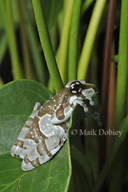|
Description
Males 77 mm, females
88 mm. The dorsum is dark brown
with large khaki-green to light brown
spots. The legs, arms and fingers have
darker brown bars with cream borders.
The snout is rounded. There is a large
khaki-green triangle between the eyes
pointing in the direction of the snout.
The dorsum has large tubercles. The
iris is golden with a black Maltese cross
centered on the pupil. There is a vocal
sac on each side of the head. Lima et al.(2005) Distribution and Habitat
Country distribution from AmphibiaWeb's database: Bolivia, Brazil, Colombia, Ecuador, French Guiana, Peru, Suriname, Venezuela
In Brazil, this species occurs throughout the Reserva Florestal Adolpho Ducke. Lima et al. (2005)
It is primarily found in primary forest. It will occupy this canopy unless it descends to a calling site, a large water-filled tree holes. (Hodl 1991)Life History, Abundance, Activity, and Special Behaviors
The species is arboreal
and nocturnal. Males call only from
water filled tree holes, at heights
between 2 and 32 m. Calling seems to only occur during rainless, cloudless nights. Calls can travel long distances through the use of the rain forest low-frequency sound window. Lima et al.(2005)
Reproduction
occurs mainly in the rainy season
between November and May. Clutches
of about 2500 eggs form a gelatinous
mass that floats near the surface of
water or adheres to the inner wall of
the tree holes. Tadpoles develop until
metamorphosis in the tree holes.
Tadpoles have dark brown dorsums and
light colored bellies. They feed on
conspecific eggs and vegetable detritus. Lima et al.(2005)
A typical call by T. resinifictrix consists of three notes similar in spectral composition. The notes have clear harmonic structures with sound energy distribution over a wide range of frequencies. At the first note of the call, there is a maximum intensity at the sixth harmonic (1300 Hz) and also increased intensities at the fourth (867) and fifths (1083) as well. The first harmonic is 216.6 Hz. Calls were separated by approximately 15.8 s and consisted of a series of 1 to 6 notes. The variable call rate was highest at the beginning of the night, and lowest at the end of the night. The mean duration of a note was 307 ms and the mean internote interval lasted 633 ms. Comments
Similar species: Osteocephalus taurinus
can be distinguished from T. resinifictrix
because it does not have a khaki-green
dorsum or a Maltese cross in the eye. Lima et al.(2005)
It is known on the upper Amazonas and the river Itacoai as "sapo canoeiro", meaning boatman frog because it croaks imitate the tapping of the oars against the side of the canoes. Lima et al.(2005)
For more information on the call site and advertisement calls of T. resinifictrix, click the "view video" button above.
Click here to download a .pdf of Hödl's (1991) paper describing the film.
References
Hodl, W. (1991). ''Phrynohyas resinifictrix (hylidae, anura) - calling behaviour.'' Wiss. Film (Wien), 42, 63-70.
Lima, A. P., Magnusson, W. E., Menin, M., Erdtmann, L. K., Rodrigues, D. J., Keller, C., and Hödl, W. (2005). Guia de Sapos da Reserva Adolpho Ducke, Amazonia Central. Átterna Design Editorial, Manaus. [link]
Originally submitted by: Albertina P. Lima, William E. Magnusson, Marcelo Menin, Luciana K. Erdtmann, Domingos J. Rodrigues, Claudia Keller, Walter Hödl (first posted 2007-11-27)
Edited by: Keith Lui (2010-10-19)Species Account Citation: AmphibiaWeb 2010 Trachycephalus resinifictrix: Boatman Frog <https://amphibiaweb.org/species/1024> University of California, Berkeley, CA, USA. Accessed Apr 23, 2024.
Feedback or comments about this page.
Citation: AmphibiaWeb. 2024. <https://amphibiaweb.org> University of California, Berkeley, CA, USA. Accessed 23 Apr 2024.
AmphibiaWeb's policy on data use.
|
